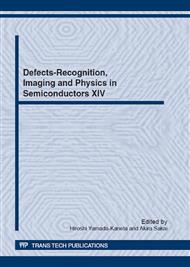p.145
p.149
p.153
p.157
p.161
p.165
p.171
p.175
p.179
Combinatorial Synthesis Study of Passivation Layers for Solar Cell Applications
Abstract:
We investigated the new materials applicable for the field effect passivation layer in crystalline Si solar cells, ZrO2-Al2O3 and ZrO2-Y2O3 binary systems, by using combinatorial synthesis method. As-deposited samples indicated hysteresis curves and flat band-voltage (VFB) shifts at capacitance-voltage (C-V) measurements. After oxygen gas annealing (OGA) at 700 oC for 5min, an improvement of the hysteresis and a positive shift of VFB were observed. OGA process influenced defects density related to decreasing oxygen vacancy. OGA processed ZrO2 incorporated with 20 % Al2O3 and 15 % Y2O3 structures showed the maximized negative fixed charge of -5.8 × 1012 cm-2 and -7.8 × 1012 cm-2 in each system, respectively, suggesting that the ZrO2 based alloy systems were revealed to be the promising material for the passivation in the solar cell application.
Info:
Periodical:
Pages:
161-164
Citation:
Online since:
July 2012
Price:
Сopyright:
© 2012 Trans Tech Publications Ltd. All Rights Reserved
Share:
Citation:



